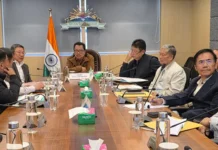Monday Musing
[ Ranjit Sinha ]
In 2021, the state government launched a series of activities in its war against the drug menace. The government found itself in a very weird situation last year when it came to know that drug peddlers as well as drug users also included a large section of government servants.
Baffled by the drug menace, Chief Minister Pema Khandu had asked all the state government employees to report about their addiction to drugs, if any, to their senior officers. “A dateline will be given, and after closing of that dateline, any government employee found indulging in drug addiction will have to face legal actions,” the CM had warned.
After the warning, there was a report about 143 people having been arrested and 86 FIRs having been registered in the state in connection with drug consumption and trafficking within one month, “much higher than the numbers of FIRs lodged and arrests made in connection with drug-related activities in 2020.”
The state cabinet had also approved the Arunachal Pradesh Policy on Psychoactive Substances, 2021-26, giving emphasis on “supply reduction, demand reduction, and harm reduction” in mid-July, 2021.
In November last year, much to the respite of the state government, 225 government employees reportedly divulged that they were under the influence of “some sort of natural or synthetic drug.” Stimulated by the revelation of the government employees, the government had also discussed employing effective de-addiction strategies and thought of a robust action plan for the rehabilitation of drug-addicted government officials in a time-bound manner.
Despite all the strategies and policy against the drug menace, 2021 ended with the arrest of four persons, including an IRBn constable, from Naharlagun area, for drug peddling and, surprisingly, 2022 began with the arrest of two persons along with a huge cache of contraband (heroin) worth more than Rs 1 crore on 12 January.
The arrest made it clear that interstate drug supplier gangs are still active in the state, and the continued supply of psychoactive substances like heroin for years in several pockets of the state is clear indication that the demand for narcotic substances in the state is increasing.
It is worth mentioning here that the law enforcing authorities in the state have been doing their best to snap the drug supply chain. Armed with the NDPS Act, the anti-drugs squad in every district comes to the forefront almost every other month against the drug menace. What irritates the most is that the government’s policy decisions like “demand reduction and harm reduction” have been failing to zero down on the demand for psychoactive substances and crack down hard on drug peddlers. Meanwhile, disorders related to substance abuse are growing manifold, creating a huge burden on individuals, families and the society as a whole.
To propel the war against the unexpected spillover drug menace, synergy between the state’s Narcotics Control Bureau, the police, the social justice, empowerment & tribal affairs department and NGOs is the need of the hour.
The government must keep in mind that the Mukhya Mantri Nasha Mukti Yojana, a flagship scheme, should not perish or disappear due to paucity of fund and shortage of manpower in the near future before it achieves visible results.



